Texas Ranger Dress Regulations
A History of Ranger Dress
The distinctive western dress of the Texas Rangers has evolved over two centuries. From 1823 to the 1870s early Rangers wore clothing suited to frontier life on horseback. There were no State clothing or equipment allowances, so each man wore what he owned and knew would work under harsh frontier conditions. Broad-brimmed hats served as protection from the sun and rain. Pants were tough enough to ward off brush. Oiled leather boots protected the feet from rocks, thorns and water.
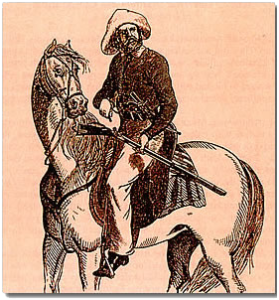
Early Ranger, 1840s
By the 'Gilded Age' of the 1890s, Rangers had become full-time professional lawmen. Captains, and many Rangers, took to dressing in suits, coats, vests, and ties around towns. They were clean shaven or had trimmed beards and moustaches, recent haircuts and looked sharp.
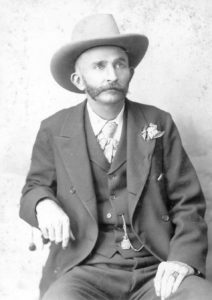
Captain Bill McDonald, about 1900
A Professional Lawman
However, this refined dress was not well-suited to the brush. Despite the wonders of trains, telegraphs and gas light, Texas was still largely frontier. In 1896, famed Captain Bill McDonald (above) was hurriedly sent after bank robbers hiding out near Wichita Falls, Texas. He arrived by train, and learning that the robbers had fled, borrowed a horse to trail the bandits.
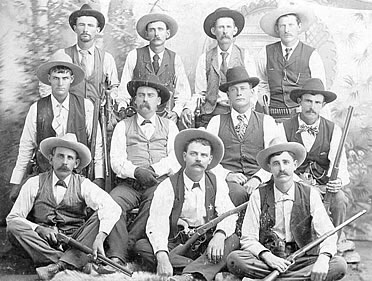
Ranger Company of the 1890s
Capt. McDonald was a skilled horseman, but the 'nag' he rode had a jackhammer gait. It was a dark night and his pursuit led 16 miles over rough ground. His horse became exhausted, stumbled, and threw the well-dressed McDonald into a bog. Spitting mad, caked with muck, he was forced to wade through freezing water. Catching up with the bank robbers in a swampy thicket he shouted "Throw up your hands or I will bore a hole in you that will let the moon shine in!"
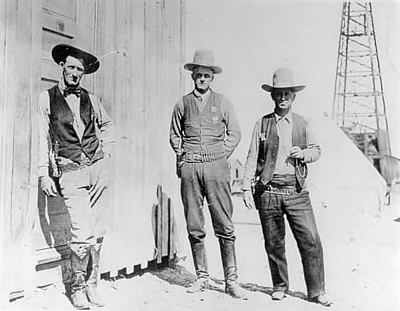
Texas Rangers in the Red River Oil Field, 1920s
Note the ties and vests.
By the 1920s, a pattern had become established that continues to this day incorporating business dress and practical field dress.
Ranking Texas Rangers, like Capt. Frank Hamer (below), wore business suits around towns. In the field, their dress remained utilitarian, sometimes echoing military cavalry dress.
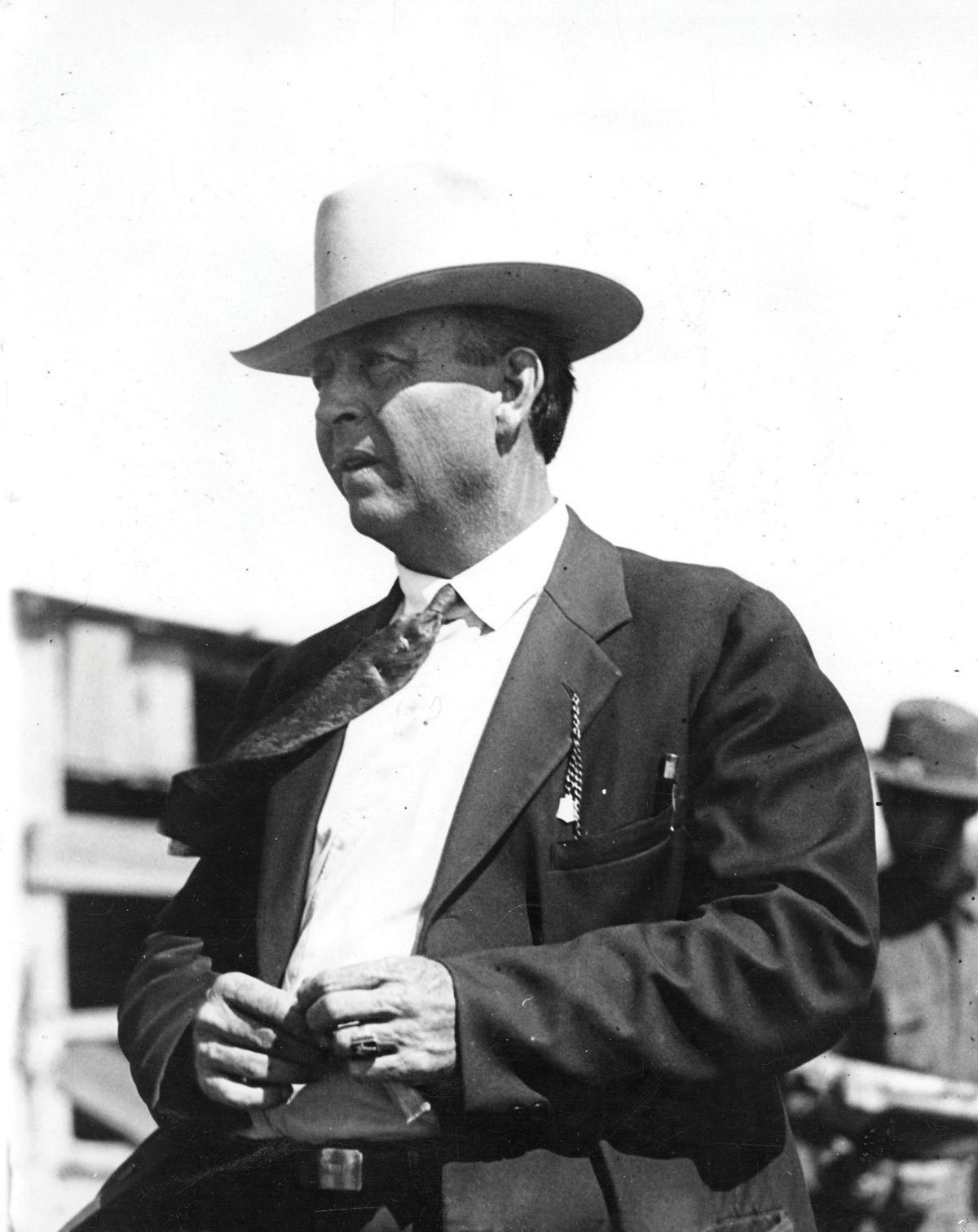
Captain Frank Hamer in Suit
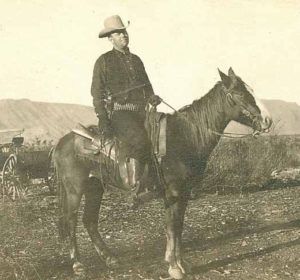
Capt. Frank Hamer dressed for the field
Note the pant legs tucked into the boots, gloves and shirt and pants reminiscent of the Army cavalry.
Texas Rangers became a staple of western movies from the 1930s through the '60s, Hundreds of movies were made starring some of the biggest Hollywood stars.
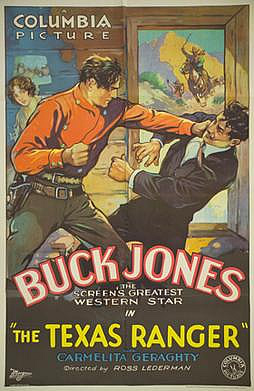
The influence of 'pop culture' movie cowboys such as Tom Mix and Buck Jones began to show in the wardrobes of some Texas Rangers (see Col. W.W. ("Bill") Sterling below right.
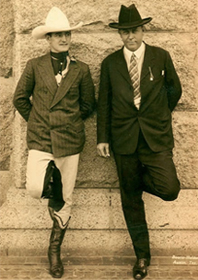
Honorary Texas Ranger and Cowboy Star Tom Mix, left, with Capt. Frank Hamer
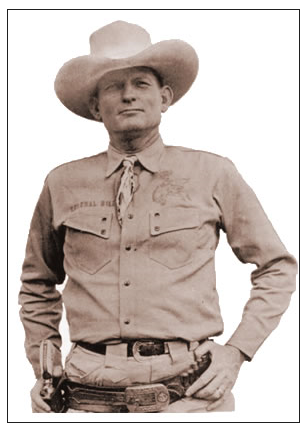
Col. Bill Sterling
Texas Ranger and Adjutant General Commanding the Texas Rangers
From the 1950s into the 1970s many Texas Rangers favored practical tan or khaki clothing, western hats, boots and distinctive longhorn tie bars. Legendary Director of Texas DPS (above), was proud of "his" Rangers and had his portrait painted dressed in what was then one type of daily wear. He also influenced and adopted the current 'circle star' Texas Ranger badge design in 1960-61
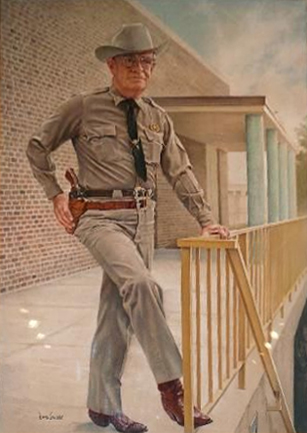
Col. Homer Garrison Jr.
Director of Texas DPS
Current Texas Ranger Dresss Regulations
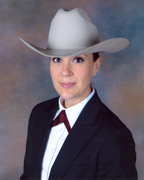
Staff Captain Melba Saenz

Chief Chance Collins
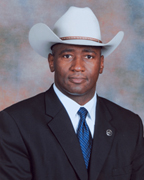
Major Creighton McGee
The dress code for current Texas Rangers specifies conservative western dress for "routine" duty and special "battle dress uniforms" (BDUs) for tactical situations involving Border reconnaissance, SWAT and rapid response teams. Suits and other less business dress clothing can be worn when making court appearances, on the Governor's security detail, and for Legislative appearances. These regulations are below.
An unexpected situation related to dress arose during Texas Governor George W. Bush's first Presidential primary campaign. As a serving governor he was guarded on the campaign trail by a security detail including Texas Rangers. The Republican Party reimbursed the State of Texas for their services during the campaign.
As some Rangers have told it, during an east coast campaign stop the Rangers working the governor's security detail were dressed in Ranger attire—western jacket, western hat, shirt, and boots. This was not exactly common dress for the east Coast. Instead of focusing on candidate Bush, the reporters rushed to interview the "real" Texas Rangers. Thereafter the campaign staff requested that the accompanying Texas Rangers appear in nondescript suits.
Dress Requirements
25.01 General Dress. Texas Ranger personnel representing the Department in their official capacity are required to dress in an appropriate manner. The appropriate clothing is deemed to be conservative western attire. Appropriate clothing other than western attire may be acceptable if such is of a conservative nature and blends with the expected western clothing. To be dressed appropriately, Rangers are required to wear a western hat, a dress shirt, a tie, a dress coat, appropriate pants, western belt, western boots, and the official Texas Ranger badge pinned above the left shirt pocket. An approved handgun should be worn in a waist holster at all times.
Clothing that is worn, torn, or faded is prohibited. All clothing will be clean, neat, and with a pressed appearance. The exceptions to this policy will be outlined below, as well as definitions to certain words and phrases. Field Majors shall be responsible for defining the terms in this section, considered too vague in description, in order to promote uniformity within their company or within the Ranger's assigned area. Certain special or non-routine occasions may arise in which the field Major may specify a specific dress for wear, within these guidelines, in order to promote uniformity within the Rangers on the specified occasion.
- Fanny Packs or Waist Purses. Fanny packs or waist purses are prohibited.
- Hats. Hats will be light-colored and shaped in a businessman's style. Styles commonly called the Rancher or Cattleman will be the only styles acceptable. Brims must not exceed 4 inches or be flat with edges rolled up. Hats excessively crushed, rolled, or dipped are not acceptable. Members of the Ranger Division will own both a quality straw and quality felt hat. Palm-leaf styled hats are prohibited. The appropriate hat will usually be determined by the weather or assignment. Both types of hats will be kept clean. Faded or worn-out hats are expressly prohibited.
- Dress Shirts. Shirts are defined as solid colored shirts or small-striped shirts. Shirts bearing outlandish designs or loud colors are expressly prohibited. Denim, faded or worn-out shirts are expressly prohibited. All shirts will be clean, neat and with a starched appearance at all times while on duty.
- Tie. Ties will be conservative. Ties for female Rangers will be optional or at the Major’s discretion.
- Dress Coats. Dress coats include suit coats, sport jackets, and other types of wind breakers, jackets, and coats. All should be clean and pressed if appropriate (suit coats and sport jackets). Faded or excessively worn dress coats are expressly prohibited.
- Appropriate Pants. Dress slacks and pants commonly known as "dress jeans" are acceptable, and must be of a solid color. Suits, whereby the coat and slacks are of the same design or style, may be worn. Dress jeans must be starched and pressed with a visible crease. Slacks or jeans that are faded, excessively worn or have frayed seams or cuffs are expressly prohibited.
- Western Boots. Boots commonly known as western boots are required; however, exaggerated under slung heels are prohibited. The boot material and color shall be of a conservative and business approach. During general dress, lace-up boots are prohibited. Boots will be shined and in good repair.
- Official Badge. There are two styles of official badges. One is the official-issued badge for the rank currently held by the Ranger. The other is an approved personalized badge that has all the official markings as the official-issue badge, except the Department of Public Safety is replaced with the Ranger's name.
- Exceptions. From time to time Rangers will become involved in manhunts, crime scene searches, surveillance, and other such duties that make the appropriate dress impractical. In such circumstances, Rangers are expected to dress for the occasion, which may deviate from the appropriate dress. A dress coat and tie should be kept readily available in case a circumstance presents itself where the absence of such dress coat and/or tie would be inappropriate.
- Special Circumstances. Court appearances, Governor's Security, Executive Security, Legislative appearances, or any other high exposure to public events requires specific appropriate dress, and requires a suit or sports coat and appropriate pants, such as dress slacks or suit. Dress jeans or “Wrangler” style jeans are expressly prohibited. Protective clothing (BDUs) will be worn for special tactical situations, tactical tracking, crime scenes, firearms training (the only exception regarding firearms training being when the Company Major determines that regular work attire will be worn, including soft body armor), and emergency/disaster related scenarios.
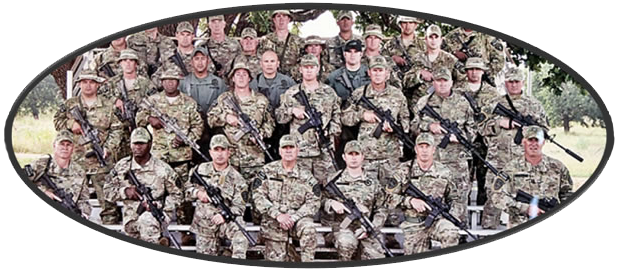
Special Response Team including Texas Rangers in BDUs
When BDUs are worn, only the uniform purchased and issued to each Ranger will be worn, to include: issued ball cap or "boonie hat", issued boots and issued T-Shirt. Firearms instructors are issued red colored (for safety) caps. Majors will evaluate any clothing items potentially needing replacement and ensure the purchase and issue of the items as they deem appropriate.
BDUs are expressly prohibited during routine Ranger duties. Nylon-issued gun belt gear will be worn only with the protective clothing or while engaged in special circumstances that would make the wearing of such gear practical. The gear is expressly prohibited during routine Ranger duties.
